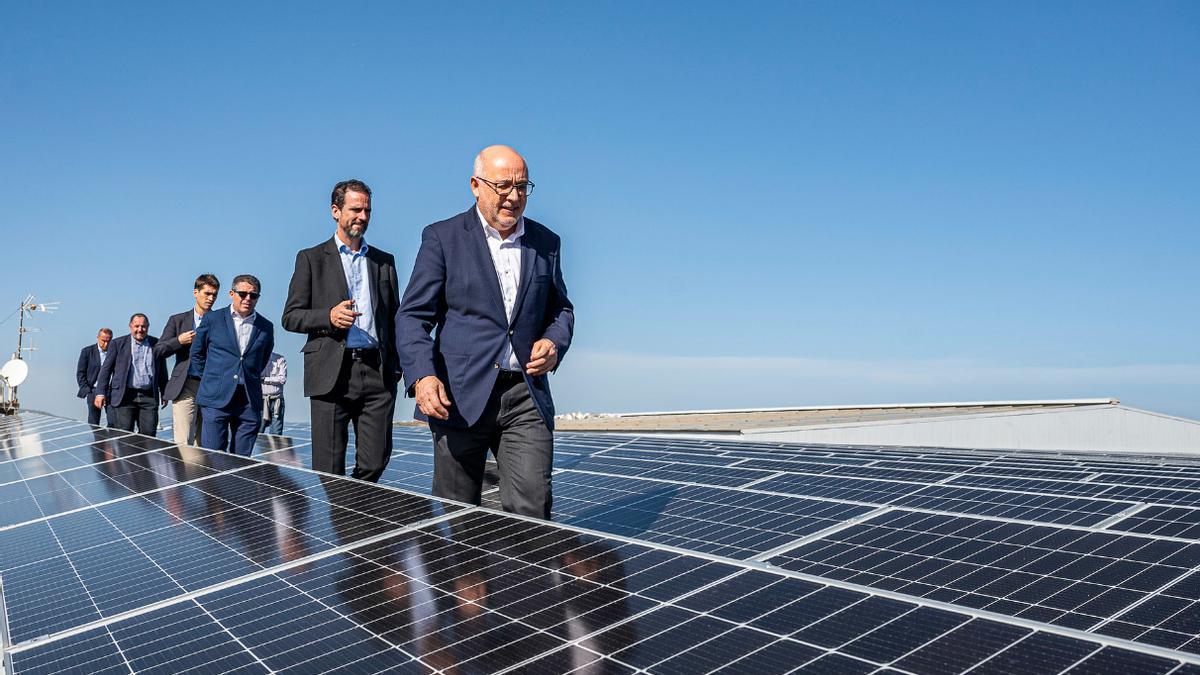
Antonio Morales at the Gran Canaria Arena photovoltaic plant / LP/DLP
The sun and wind in Gran Canaria, particularly in the southeastern region of the island, have been pioneering in encouraging and supporting the shift towards a renewable energy model in the archipelago. This historic initiative has been taken up by the Gran Canaria Council and, for the past decade, we have been steadfastly progressing towards decarbonisation.
This has been achieved with a roadmap that has stayed true to its core objectives and has avoided going down gas-related paths that would have delayed and worked against this transition. The addition of new photovoltaic plants inaugurated in Telde and Agüimes introduces new and significant pieces to this puzzle to create a more sustainable future for our territory. It also helps to consolidate the island’s position as the leading island territory in the introduction of renewable energies in the archipelago.
Renewable energy introduction data speaks volumes. In Gran Canaria, the total installed renewable power in April 2024 was 382.6 MW compared to 343.8 MW in the island of Tenerife and 134 MW in Lanzarote and Fuerteventura. The renewable production in Gran Canaria is 217 GWh compared to 172.3 GWh in Tenerife and 70 in the rest of the islands.
The integration of renewables on our island is at 20% compared to 15% in Tenerife and 14% in Fuerteventura and Lanzarote. An important fact is that the spillages amount to 21,258 MWh, multiplying by four that of the other islands, highlighting the need and opportunity to have storage resources for these energies, for which we have Salto de Chira, which will fulfil this pivotal function.
Ultimately, this helps us progress along the necessary path towards an increasingly sustainable model that is part of our comprehensive Ecoisland project. It’s a journey that cannot afford deviations or delays in the current context of global warming and adaptation to the effects of climate change.
Naturgy’s strong commitment to driving the energy transition in Canary Islands, especially on this island conveys other messages. It clearly expresses how companies in the sector acknowledge that Gran Canaria offers a favourable social and political ecosystem for such investments, thanks to the leadership of the Council and the consensus achieved to promote the energy transition.
In this regard, we can now proudly announce that two of the plants were processed through a public and social interest file of the Council. However, we need to simplify and expedite procedures because we are inaugurating parks whose process started seven years ago in the Canary Islands Government. These timelines are incompatible with the planetary climate urgency and our commitment to global energy transition. Administrative red tape, lack of human resources, and certain neonegationist retardation entrenched in some areas are hurdles that need to be overcome.
The data supports the steps taken over the last decade by the island’s government. The installed photovoltaic capacity has grown by 25%. Furthermore, we have extended this revolution to our facilities and now have, for example, the most powerful solar plant managed by a public administration in the Canary Islands, complemented by the commitment to reduce the carbon footprint in the industrial water treatment and production chain.
Furthermore, realizing the importance of involving the entire social and economic fabric of Gran Canaria in this paradigm shift, we have increased incentives for self-consumption or the implementation of energy communities, currently leading in this statistic, making almost half of this production variant concentrated on the island. Additionally, our commitment to continue uniting wills in this transformative process has also materialized in the creation of the Offices for Community Transformation and Energy Transition or the Covenant of Mayors. It adds to being the first territory in the archipelago to have a Strategy for Mitigation and Adaptation to Climate Change.
However, we are aware that the challenges are so significant that we cannot stop here. That is why we have a strategy that will enable us to reach 60% penetration of clean energies by 2030, incorporating new milestones confirming the island’s vanguard position, including the fact that Gran Canaria will be the first territory in the country to implement offshore wind energy after reaching an agreement with the Ministry of Ecological Transition.
In this future landscape, in the short term, as mentioned at the beginning of this text, the emergence of the Salto de Chira plant as a significant storage resource and introduction of renewables and water production for agriculture will stand out. This project, which harnesses the dams built by our ancestors and inherits their strategic vision, also embodies the principles of energy sovereignty, food sovereignty, and water security. Other similar operational projects will follow, utilizing other dams and generating other waterfalls, this time with seawater.
These pillars are also the foundation of an island based on a more inclusive, ecological, and social economic development. Therefore, projects like the ones just inaugurated in Gran Canaria strengthen this path towards sustainability, while also creating employment and economic diversification.
[–>
Finally, I would like to congratulate Naturgy as the promoting company and all the technical and installation teams that have executed the projects diligently and timely. Today, we can celebrate together as we take another step forward guided and inspired by the sun of Gran Canaria.
















